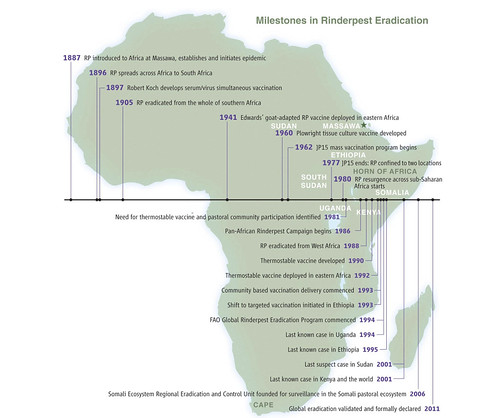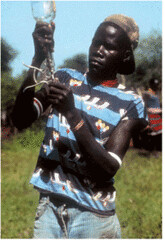Banalata Das, a dairy and shrimp farmer, feeds her cow in Khulna, Bangladesh (photo credit: WorldFish/Mike Lusmore).
Ramadjita Tabo, a member of The Montpellier Panel and deputy executive director of the Forum for Agricultural Research in Africa (FARA), recently described the recent rather divisive nature of academic discussions on the viability of the ‘sustainable intensification’ of agriculture as follows.
Sustainable intensification, an agricultural development pathway that aims to reconcile food production and environmental protection, is a highly politicised term that divides academics and practitioners alike. Although, when first coined by Jules Pretty, the term was a way of bringing often divergent priorities such as addressing declines in land and agricultural productivity, pollution and food insecurity together under a new paradigm, it has been since accused of being a ruse for big, industrial agriculture. — Ramadjita Tabo, Sustainable intensification: A practical approach to meet Africa’s food and natural resource needs, Global Food Security blog, 18 Apr 2013
Now a team of diverse scientists and other experts, having broadened the concept, make a case in a new report published in the journal Science that sustainable intensification is absolutely central to our ability to meet increasing demands for food from our growing populations and finite farmlands.
Tara Garnett and Charles Godfray, the article’s lead authors, say that we can increase food production from existing farmland if we employ sustainable intensification practices and policies. These, they say, can help minimize already severe pressures on the environment, especially for more land, water, and energy, natural resources now commonly overexploited and used unsustainably.
The authors of this Science ‘Policy Forum’ piece are researchers from leading universities and international organizations as well as policymakers from non-governmental organizations and the United Nations. One of the co-authors is Mario Herrero, an agricultural systems scientist who recently led a ‘livestock futures’ team at the International Livestock Research Institute (ILRI, a member of CGIAR), in Nairobi, Kenya, and who earlier this year moved to Brisbane, Australia, to take up the position of chief research scientist for food systems and the environment at the Commonwealth Scientific and Industrial Research Organisation (CSIRO). Another co-author is Philip Thornton, another ILRI systems scientist and a leader of a multi-institutional team and project in the CGIAR Research Program on Climate Change, Agriculture and Food Security (CCAFS).
The authors of this Science paper outline a new, more sophisticated account of how ‘sustainable intensification’ should work. They recognize that this policy has attracted criticism in some quarters as being either too narrowly focused on food production or as representing a contradiction in terms.
We need to come up with suitable practical indicators of just what is sustainable, and the fact is that we’ll sometimes need to reduce intensification, as in places where additional increases in yields or efficiencies could place too much pressure on other facets of food systems. — Mario Herrero, agricultural systems scientist, CSIRO (formerly of ILRI)
Herrero’s colleague, Philip Thornton, agrees. And he reminds us of the ‘multi-functionality’ of agricultural production systems in developing countries, particularly livestock systems in sub-Saharan Africa. ‘These ‘multifunctions’ (such as keeping cows for household milk, and/or to generate a daily household dairy income, and/or to produce manure to fertilize croplands, and/or to transport produce to markets, and/or or to build household assets) differ by place and context, and our interventions aiming to enhance them need to differ accordingly, Thornton says. No ‘silver bullets’ or ‘one-size-fits-all’ approach, he says, is going to work in these varied smallholder production system contexts.
The main reason for producing this Science paper was to try to wrest the concept of ‘sustainable agricultural intensification’ back from those driving specific agendas. (We may well have to try to do the same for ‘climate-smart agriculture’, but that’s another story.) — Philip Thornton, ILRI and CCAFS
Similar arguments were published in a previous article in Science by Herrero, Thornton and their colleagues (Smart investments in sustainable food production: Revisiting mixed crop-livestock systems, Science, 12 Feb 2010, DOI: 10.1126/science.1183725). This new investigation, Herrero says, is something of a follow-up to that earlier paper. The new Science article stresses that while farmers in many regions of the world need to produce more food, it is equally urgent that policymakers act on diets, waste and how the food system is governed. The authors say we must produce more food on existing rather than new farmland; converting uncultivated land, they say, will lead to greater emissions of greenhouse gases, which are causing global warming, and greater losses of biodiversity.
The authors make a strong case for sustainable intensification being the only policy on the table that could generate ways of producing enough food for all without destroying our environment.
But, warns Charles Godfray, of the Oxford Martin Programme on the Future of Food, sustainable intensification should be only one part of an agricultural and development policy portfolio. ‘Sustainable intensification is necessary’, he says, ‘but not sufficient’.
Achieving a sustainable food system will require changes in agricultural production, changes in diet so people eat less meat and waste less food, and regulatory changes to improve the efficiency and resilience of the food system. Producing more food is important but it is only one of a number of policies that we must pursue together. — Charles Godfray, Oxford Martin Programme on the Future of Food
Increasing productivity does not always mean using more fertilizers and agrochemicals, which frequently carry unacceptable environmental costs, argue the authors. They say that a range of techniques, both old and new, should be employed to develop ways of farming that keep environmental damage to a minimum.
The authors of the paper accept that the intensification of agriculture will directly as well as indirectly impact other important policy goals, such as preserving biodiversity, improving human nutrition and animal welfare, protecting rural economies and sustaining development generally in poor countries and communities. Policymakers will need to find ways to navigate conflicting priorities, they say, which is where research can help.
Lead author Tara Garnett, from the Food Climate Research Network at the Oxford Martin School, says that food security is about more than just more calories. Better nutrition also matters, she says.
Some two billion people worldwide are thought to be deficient in micronutrients. We need to intensify the quality of the food we produce in ways that improve the nutritional value of people’s diets, preferably through diversifying the range of foods produced and available to people but also, in the short term, by improving the nutrient content of crops now commonly produced. — Tara Garnett, Food Climate Research Network
Michael Appleby, of the World Society for the Protection of Animals, says that ‘Attention to livestock welfare is both necessary and beneficial for sustainability. Policies to achieve the right balance between animal and crop production will benefit animals, people and the planet.’
Agriculture is a potent sector for economic growth and rural development in many countries across Africa, Asia and South America, says co-author Sonja Vermeulen, of CCAFS.
Sustainable intensification can provide the best rewards for small-scale farmers and their heritage of natural resources. What policymakers can provide are the strategic finance as well as institutions needed to support sustainable and equitable pathways rather than quick profits gained through depletion. — Sonja Vermeulen, CCAFS
Get the paper: Sustainable intensification in agriculture: Premises and policies, by T Garnett, MC Appleby, A Balmford, IJ Bateman, TG Benton, P Bloomer, B Burlingame, M Dawkins, L Dolan, D Fraser, M Herrero, I Hoffmann, P Smith, PK Thornton, C Toulmin, SJ Vermeulen, HCJ Godfray, Science, vol. 341, 5 Jul 2013.
Note
ILRI director of institutional planning and partnerships, Shirley Tarawali, will be travelling to Accra, Ghana, tomorrow (9 Jul 2013) to take part in a 4-day workshop (10–13 Jul 2013) for major stakeholders in sustainable agricultural intensification in Africa. The participants will explore the links between systems research and sustainable intensification to refine and reach a common understandings.
The workshop also aims to help determine:
1) factors critical for successful sustainable intensification
2) institutional arrangements for integrating sustainable intensification into investment and service delivery programs
3) best mechanisms for sharing and learning across Africa’s major sustainable intensification programs.
About 50 people will participate in this sustainable intensification workshop, representing the Forum for Agricultural Research in Africa (FARA); Africa’s sub-regional and non-governmental organizations, national agricultural research systems, universities and farmer organizations; CGIAR centres and research programs; and major African sustainable intensification programs, financing organizations and investors.
More information
Contact the University of Oxford Press Office on +44 (0)1865 280534 or email press.office@admin.ox.ac.uk
Contact taragarnett [at] fcrn.org.uk or charles.godfray [at] zoo.ox.ac.uk
Contact Shirley Tarawali: s.tarawali [at] cgiar.org
The Science article follows a workshop on food security convened by the Oxford Martin School and the Food Climate Research Network at the University of Oxford; a more detailed account of the workshop is at: http://www.futureoffood.ox.ac.uk/sustainable-intensification
Tara Garnett runs the Food Climate Research Network: http://www.fcrn.org.uk
Charles Godfray is the Director of the Oxford Martin Programme on the Future of Food: http://www.futureoffood.ox.ac.uk
For more information on the Oxford Martin School, please visit http://www.oxfordmartin.ox.ac.uk/
Michael Appleby is chief scientific adviser for humane sustainable agriculture at the World Society for Protection of Animals: www.wspa.org.uk
Sonja Vermeulen is head of research at the CGIAR Research Program on Climate Change, Agriculture and Food Security: http://ccafs.cgiar.org
Addendum
Simon West, a PhD student within a GLEAN project and working at the Stockholm Resilience Centre, has an interesting point to make about the importance of ‘learning’ at the interface of ecosystem management and sustainable development (One thought on GLEAN @ STEPS summer school, 30 May 2013).
‘. . . My research examines the production of learning within ecosystem management, and how such learning – informed by mental models, narratives and framing of ecological change – affects the way that people interact with their environment. Learning is increasingly recognized as critical in achieving transitions toward sustainable development – but how does such learning take place, and what types of learning are required? Scholars from different disciplinary backgrounds will answer these questions in very different ways, and such differences reveal the contestation at the heart of any idea of sustainable development. . . .
‘Even in open and inclusive participatory processes decisions have to be made which inherently require closing down around particular courses of action; the success of one narrative (even if the narrative was previously marginalized) will inevitably come at the expense of others. Not everyone in a participatory process can necessarily ‘win.’ . . .
‘[T]oo much emphasis (by any discipline looking at sustainability issues) on developing any kind of “general content” of learning for sustainability is likely to be misguided. . . . I would argue that a more productive goal would be to encourage a new structure to knowledge, moving towards an ability to think in terms of complexity, multiple variables, interaction of social and ecological factors and temporal and spatial variability, in order to facilitate understanding of the adaptive and dynamic relations between values, framings and narratives, and the material environment.
‘Most importantly, this may lead to the realization that others in all contexts . . . will have wildly different, but equally legitimate, understandings of reality and what really matters – and this is perhaps the hardest concept for all of us, not least scientists, to really grasp.’




